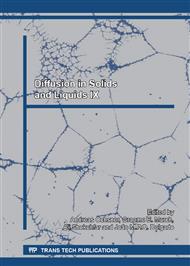p.205
p.211
p.217
p.223
p.228
p.233
p.239
p.244
p.248
Microstructure of Sodium or Potassium Added Mg-Ni Eutectic Alloy
Abstract:
The microstructure of sodium or potassium added Mg-23.5 mass%Ni eutectic alloy was observed and the effect of sodium and potassium addition on the eutectic structure was investigated. All alloys showed the eutectic structure which composed of Mg phase and Mg2Ni phase, and no evidence of the sodium or potassium precipitation occurred. For the sodium added and furnace cooled alloy, the lamellar spacing in the eutectic structure became a little narrow and the Mg2Ni phase tends to become fragmentary as the amount of sodium increases. The sodium addition has a little effect for the refinement of the eutectic structure. For the potassium added and furnace cooled alloy, the lamellar spacing of the eutectic structure became clearly narrow even by the 0.1 mass% potassium additions. The morphology drastically varied in more than 0.5 mass% potassium added specimens, that is, the refinement and fragmentation of the Mg2Ni phase occurred. The potassium addition has a large effect for the refinement and the fragmentation of the Mg2Ni phase in the eutectic structure. For the water quenched specimens, the eutectic structure was extremely fine and globular shape with and without the additive element. The refinement effect by the water quenching is remarkably high even as the non-added specimen. The effect of sodium and potassium addition on the refinement of eutectic structure is not clear in the case of the rapid cooling speed during solidification.
Info:
Periodical:
Pages:
228-232
Citation:
Online since:
May 2014
Authors:
Price:
Сopyright:
© 2014 Trans Tech Publications Ltd. All Rights Reserved
Share:
Citation:


